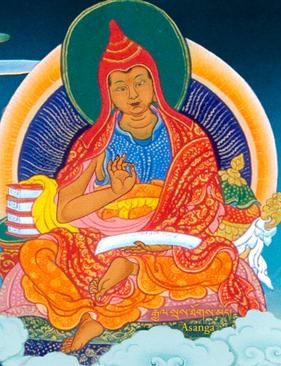Bhumi: Difference between revisions
Jump to navigation
Jump to search
mNo edit summary |
No edit summary |
||
| Line 1: | Line 1: | ||
[[Image:Asanga.JPG|thumb|[[Asanga]], author of the ''[[Bodhisattva Bhumis]]'']] | [[Image:Asanga.JPG|thumb|[[Asanga]], author of the ''[[Bodhisattva Bhumis]]'']] | ||
'''Bhumi''' (Skt. ''bhūmi''; Tib. [[ས་]], [[Wyl.]] ''sa''), stage or level — the word ''bhumi'' literally means ‘ground’. Just as the ground is the support for everything, both animate and inanimate, the bhumis are said to be ‘supports’ for [[enlightened qualities]]. So this term is used when referring to the stages | '''Bhumi''' (Skt. ''bhūmi''; Tib. [[ས་]], [[Wyl.]] ''sa''), stage or level — the word ''bhumi'' literally means ‘ground’. Just as the ground is the support for everything, both animate and inanimate, the bhumis are said to be ‘supports’ for [[enlightened qualities]]. So this term is used when referring to the stages practitioners traverse on the path to [[enlightenment]]. There are the [[eight grounds]] of the [[Hinayana]] path, the [[ten bhumis]] in the [[Sutra]] [[Mahayana]], with the eleventh being buddhahood, and thirteen in the [[Tantrayana]]. The [[Dzogchen]] teachings sometimes speak of [[sixteen bhumis]]. | ||
==Translation== | ==Translation== | ||
[[Dzongsar Khyentse Rinpoche]] has said: | |||
:. | :What makes a bhumi? Simply, it is a combination of wisdom and method. In Sanskrit, bhumi literally means earth, land or country – it can refer to many things. For example, in Indonesia, the language has a lot of Sanskrit influence. In their official forms, they use words like ‘bhumiputra’ when they talk of citizenship. We use the name ‘bhumi’ for the combination of wisdom and method because the ground or earth acts like a container for all things to function. For example, you can hoist this tent because of the ground. Likewise, all the enlightened qualities can grow on the base of the combination of wisdom and method.<ref> Dzongsar Khyentse Rinpoche, Introduction to the Middle Way, Khyentse Foundation, 2003, p.24</ref> | ||
==Notes== | ==Notes== | ||
Revision as of 03:31, 19 January 2012

Bhumi (Skt. bhūmi; Tib. ས་, Wyl. sa), stage or level — the word bhumi literally means ‘ground’. Just as the ground is the support for everything, both animate and inanimate, the bhumis are said to be ‘supports’ for enlightened qualities. So this term is used when referring to the stages practitioners traverse on the path to enlightenment. There are the eight grounds of the Hinayana path, the ten bhumis in the Sutra Mahayana, with the eleventh being buddhahood, and thirteen in the Tantrayana. The Dzogchen teachings sometimes speak of sixteen bhumis.
Translation
Dzongsar Khyentse Rinpoche has said:
- What makes a bhumi? Simply, it is a combination of wisdom and method. In Sanskrit, bhumi literally means earth, land or country – it can refer to many things. For example, in Indonesia, the language has a lot of Sanskrit influence. In their official forms, they use words like ‘bhumiputra’ when they talk of citizenship. We use the name ‘bhumi’ for the combination of wisdom and method because the ground or earth acts like a container for all things to function. For example, you can hoist this tent because of the ground. Likewise, all the enlightened qualities can grow on the base of the combination of wisdom and method.[1]
Notes
- ↑ Dzongsar Khyentse Rinpoche, Introduction to the Middle Way, Khyentse Foundation, 2003, p.24
Internal Links
- ten bhumis
- thirteen bhumis
- sixteen bhumis
- twenty-one bhumis according to Anuyoga